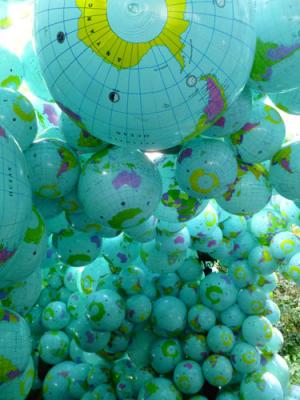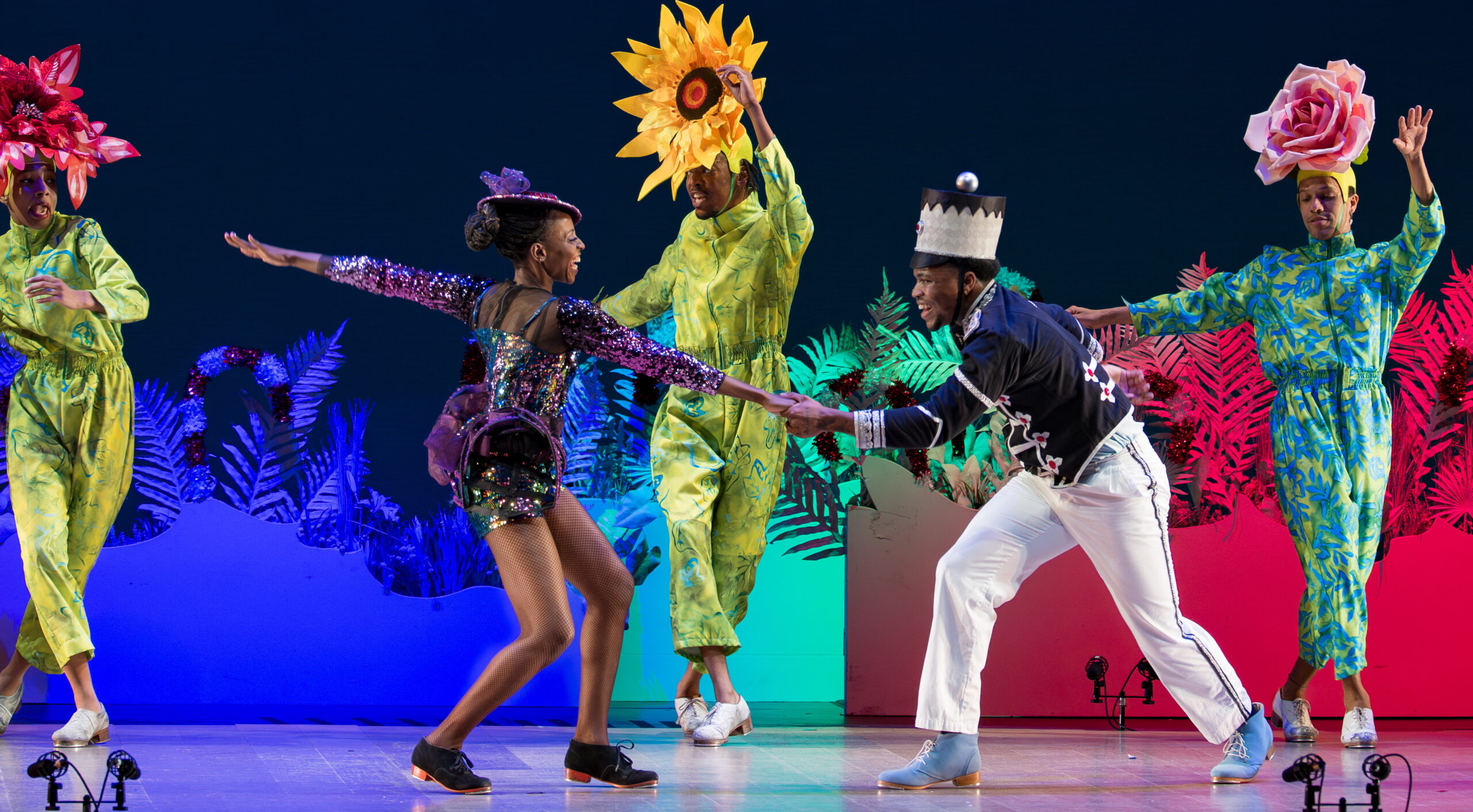The Fowler Museum at UCLA will honor its 50th anniversary (!) with a suite of special exhibitions and programs from fall 2013–fall 2014. The exhibitions in the fall of 2013 will fill the Fowler’s Getty Trust and Lucas Family galleries with nearly 1,000 objects from the Fowler’s vast, acclaimed, and diverse permanent collections.
Full list of Fall 2013 Fowler at Fifty exhibitions.
First up is the launch event—Fowler at Fifty Anniversary Celebration
Saturday, October 12, 2013
7-8 PM Members Preview
8-10 PM General Admission
- Preview an impressive suite of nine intimate exhibitions featuring nearly 1,000 objects from the Fowler’s acclaimed global collections
- Groove to live world music and dance
- Savor delectable cuisine and signature cocktails by some of LA’s favorite chefs
- Experience the Fowler building transformed by a surprise artist’s commission
- And more delights and enchantments to come!
Individual Tickets: $50.00 each
Free Opening Day Events
Sun, Oct 13, 2013
1–4 pm Kids in the Courtyard
Celebrate the Fowler’s birthday in style in an afternoon of music and art-making! Discover Amalia Mesa-Bains’ New World Wunderkammer and make your own mini cabinet full of special things. Experiment with emojis and pictographs from around the world to make your own language and explore new family resources linked to the exhibitions.
Live music at 2 pm by Samba Society!
2 pm and 3 pm Opening Day Artist Talks: Amalia Mesa-Bains and Máximo González
Featured artists Amalia Mesa-Bains (New World Wunderkammer) and Máximo González (Walk among Worlds, pictured above) discuss their creative practices during back-to-back talks at 2 pm (Mesa-Bains) and 3 pm (González).
The Exhibitions:
Walk among Worlds, an immersive outdoor installation by Mexico City-based artist Máximo González, will debut at the Fowler’s Museum’s 50th anniversary celebration on Sat., Oct. 12, 2013, and be on display through Nov. 3, 2013. Walk among Worlds incorporates thousands of beach-ball globes that will appear to float up the walls of the Museum’s Davis Courtyard and billow out the top. Explains Marla C. Berns, Shirley & Ralph Shapiro Director of the Fowler Museum, “Walk among Worlds is a fitting metaphor for a visit to the Fowler on the occasion of the Museum’s 50th anniversary, during which we are offering an especially rich array of thematic exhibitions with nearly 1,000 artworks from the Fowler’s vast, acclaimed global collections.”
Fowler at Fifty
Fowler at Fifty celebrates the remarkable trajectory of the Fowler Museum’s growth over the last five decades. Opening to the public on Oct. 13, 2013 is a suite of eight exhibitions that honor the achievements of the Museum. Each exhibition features a particular strength of the Museum’s now-vast holdings, and each takes a distinctive curatorial approach or engages an artist’s perspective. Together the eight anniversary exhibitions reveal the depth, breadth, range, and quality of the Museum’s collections. The ideas and interpretations encompassed in each communicate just what an institution can do with such expansive resources.
Fowler at Fifty contributes to global knowledge and cross-cultural understanding at the same time that it attests to the power of multiple voices and viewpoints and engenders an appreciation of local artistry and ingenuity—extending from the deep past to the present moment. On the occasion of this milestone, the Fowler underscores its long-held conviction that artworks are never static in meaning or in value but are instead dynamic resources, subject to reevaluation, reinterpretation, and reconsideration over time.
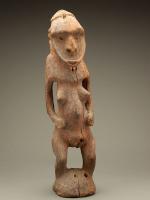
From the Sepik River to Los Angeles: Art in Migration
Oct. 13, 2013–Mar. 2, 2014
The Fowler Museum’s collections today include more than 4,500 masks, figural sculptures, shields, architectural elements, ritual objects, and other items from the island of New Guinea in the South Pacific. Three quarters of these were acquired via private donations in the short period from 1963 to 1969, and most came originally from the Sepik River region (now part of the nation of Papua New Guinea). What factors, both here and in distant New Guinea, conspired to drive this surge of so-called “primitive” art to Southern California? This exhibition showcases, for the first time since 1967, more than fifty of the finest examples of Sepik art to arrive on our shores in such short order. It also explores how this massive migration changed both the art itself and the ways we think about it.
This exhibition was curated by Roy W. Hamilton, Senior Curator of Asian and Pacific Collections, Fowler Museum at UCLA with Michael Hamson.
Double Fortune, Double Trouble: Art for Twins among the Yorùbá 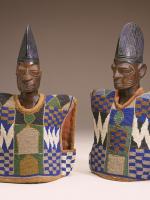
Oct. 13, 2013–Mar. 2, 2014
This exhibition explores the power and prevalence of “two-ness” in Yorùbá art and thought with an impressive display of more than 250 carved wood twin memorial figures, known as ere ibeji. The Yorùbá, who live in southwestern Nigeria as well as Togo and Benin, have one of the highest rates of twinning in the world, and special attention is paid to twins, both in life and after. These works from the Fowler’s extraordinary collection display a remarkable stylistic range and illuminate issues of apprenticeship and mastery, local innovation and invention, and the ways their surfaces and adornments show how they were treated and transformed once they left the sculptors’ hands and moved into the hands, hearts, and minds of family members. Additionally, contemporary artist Simone Leigh’s newly commissioned installation Topsy Turvy will incorporate West African plastic dolls (that sometimes substitute for the carved figures) in a dramatic suspended work. Leigh creates sculpture, videos, and installations informed by her interest in African art, ethnographic research, feminism, and performance.
This exhibition was curated by Henry John Drewal, Evjue-Bascom Professor of African and African Diaspora Arts, University of Wisconsin, Madison, with Betsy D. Quick, Director of Education and Curatorial Affairs, Fowler Museum at UCLA.
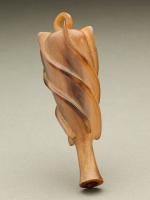 Powerful Bodies: Zulu Arts of Personal Adornment
Powerful Bodies: Zulu Arts of Personal Adornment
Oct. 13, 2013–Mar. 2, 2014
In nineteenth-century southern Africa, highly individualized arts of personal adornment experienced a florescence among isi-Zulu-speakers, people now called “the Zulu.” Personal objects worn on or carried around the body were made with considerable aesthetic investment and announced status and identity. Intimate objects like ivory hairpins and snuff spoons were worn in elaborate hairstyles; beautifully crafted snuff bottles were worn against the body, suspended from belts and necklaces; and finely sculpted staffs and clubs carried by all adult men were prized possessions. Men and women wore intricately sewn, jewel-colored beadwork to accentuate bodily “zones of power”: necklaces drew attention to the head; beaded fringes and belts highlighted the reproductive organs; and bracelets and anklets emphasized the hands and feet. Powerful Bodies includes seventy-nine fine examples of such objects, which were often imbued with the physical traces of their former users.
This exhibition was curated by Anitra Nettleton, Chair and Director, Center for the Creative Arts of Africa, Faculty of Humanities/Wits Art Museum, Wits School of Arts, University of the Witwatersrand, South Africa, with Gemma Rodrigues, Curator of African Arts, Fowler Museum at UCLA.
Māori Cloaks, Māori Voices 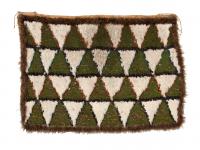
Oct. 13, 2013–Mar. 2, 2014
When the ancestors of the Māori people sailed to Aotearoa (New Zealand) roughly nine hundred years ago, they became the first Polynesians to settle a land outside the tropics. Previous generations of Polynesians had little need for clothing and made thin beaten barkcloth more for ceremonial purposes than for warmth. In Aotearoa, Māori women abandoned making barkcloth and turned instead to the harakeke plant (New Zealand flax, Phormium tenax), developing new techniques to twine its fibers into garments by hand, without benefit of a loom.
The finest cloaks, including some covered with stunning, iridescent feather work, transcended practical needs and became treasured markers of prestige. This exhibition features thirteen rare and beautiful nineteenth- and early-twentieth century cloaks, shown publicly for the first time since their arrival in Los Angeles in 1965 as part of the gift from the Wellcome Ethnological Collection in London (see “History of the Fowler” on page 5). The exhibition includes a video in which a panel of Maori artists and scholars comment on the cloaks and their ongoing meanings and relevance.
This exhibition was curated by: Tharron Bloomfield (Ngāti Porou), Mellon Fellow, UCLA/Getty Conservation Program; Michelle Erai (Ngā Puhi, Ngāti Whātua, and Ngāti Porou), Assistant Professor, Gender Studies, UCLA; Roy W. Hamilton, Senior Curator of Asian and Pacific Collections, Fowler Museum at UCLA; Karl Rangikawhiti Leonard (Te Arawa, Ngāti Awa, and Ngāti Raukawa), Fulbright Fellow, Flathead Valley Community College; and Rangi Te Kanawa (Ngāti Maniapoto), Textile Conservator, Te Papa Tongarewa Museum of New Zealand.
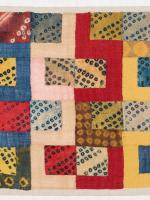 The Peruvian Four-Selvaged Cloth: Ancient Threads/New Directions
The Peruvian Four-Selvaged Cloth: Ancient Threads/New Directions
Oct 13, 2013–Jan 26, 2014
The tradition of weaving textiles with four finished edges—selvages—characterizes the creative process of the ancient weavers of Peru, known for their mastery of color, technique, and design. Without cutting a thread, each textile was woven to be what it was intended, whether a daily garment, royal mantle, or ritual cloth. This approach to weaving required the highest level of skill—even for the simplest of plain undecorated cloth—and reflects a cultural value in the integrity of cloth, not only in its design and function but in the way in which it was made.
This exhibition highlights selections from the Fowler Museum’s noteworthy collection of Pre-Columbian textiles and includes masterworks that demonstrate the extremely high level of artistic achievement of Peruvian weavers. These range from the ancient ritual textiles from the early Chavin and Paracas cultures (500–100 B.C.E.) to the extraordinary garments of the Inca empire (1485–1532). While exploring the origins and development of this approach to weaving, the exhibition will also examine its influence on three contemporary artists―Shelia Hicks, John Cohen and James Bassler—each of whom through his or her own artistic path has considered and transformed ancient weavers’ knowledge and processes into new directions.
This exhibition was curated by Elena Phipps, Independent Scholar and Curator.
New World Wunderkammer: A Project by Amalia Mesa-Bains
Oct 13, 2013–Jan 26, 2014
Chicana artist Amalia Mesa-Bains is working with the Fowler Museum’s collections to create New World Wunderkammer, which will include three “cabinets of curiosity” representing Africa, the indigenous Americas, and the complex cultural and racial mixture (Colonial mestizaje) that typifies the New World. Over two decades, Mesa-Bains has created installations that intervene in and disrupt the conceptual foundations of European museum collecting and display. New World Wunderkammer will be the first time she has utilized the holdings of a major museum to recontextualize hundreds of objects within the themes of memory, struggle, loss, and wonder. Following both a personal and professional trajectory, Mesa-Bains will weave elements from her previous installations into this work. The space will be completed by eight new prints made by the artist based on key pieces from the Fowler collection; images of artworks will be layered with botanical, cartographic, and historical photographic references. This theater of wonder will animate the cultural landscape and human geography of the New World through objects of beauty and narratives of power.
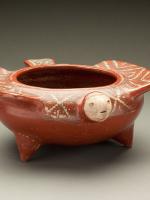 Chupícuaro: The Natalie Wood Gift of Ancient Mexican Ceramics
Chupícuaro: The Natalie Wood Gift of Ancient Mexican Ceramics
Oct 13, 2013–Jan 26, 2014
Purchased for the museum in 1969 by the late actress Natalie Wood, the Fowler’s extensive Chupícuaro holdings are its most important collection of ancient Mesoamerican art. This selection of nearly seventy works illustrates the breadth of Chupícuaro’s remarkable ceramic tradition. Because Chupícuaro’s vivid palette and bold patterning stand alone among Preclassic cultures, its origins and legacy have elicited great debate. New investigations in the Acámbaro Valley, however, have enhanced our understanding of this culture’s rich history and its place at the intersection of two cultural spheres: the West Mexican lands along the Pacific coast, and the Basin of Mexico, the Mesoamerican heartland. Recent data suggests that the Chupícuaro migrated inland from the west, along the Lerma River, and settled into the fertile Acámbaro Valley circa 600 B.C.E. While artists drew on the source traditions of ancient Colima, Jalisco and Nayarit, they experimented with colors and forms, ultimately developing a stark visual language. Large hollow figurines, mammiform tripods, jars, and cylinder vessels are juxtaposed with works from neighboring traditions to reveal Chupícuaro’s complex roots and rich legacy.
This exhibition was curated by Victoria Lyall, Associate Curator, Art of the Ancient Americas, Latin American Department, Los Angeles County Museum of Art, and Francisco Javier Martínez Bravo, Archaeologist, University of Guanajuato, Mexico, with Patrick A. Polk, Curator of Latin American and Caribbean Popular Arts.
From X to Why: A Museum Takes Shape 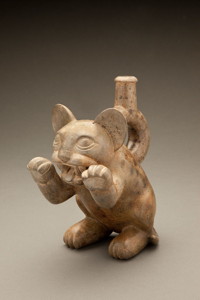
Oct 13, 2013–Mar 2, 2014
From X to Why: A Museum Takes Shape focuses on the Fowler Museum’s formative history through its earliest acquisitions. These works reveal the strength and breadth of the collection and foreshadow the Fowler’s role as one of the premier museums for preserving and exhibiting works of art from cultures around the world. The installation begins with the very first object to enter the collection, a magnificent Balinese ceremonial textile, and continues with thirty-five objects including African sculpture, American Indian pottery and basketry, Latin American ceremonial dress, Peruvian vessels, Indonesian puppets, and European Carnival masks. The exhibition also addresses how objects assume new lives in the museum context. The Fowler staff assigns a number with the prefix “X” to every object that enters the collection. “X” marks the object’s transition from a previous context of use and display to its new life and roles within the museum.
This exhibition was curated by: Peter L. Haffner, Elyan Jeanine Hill, Dana L. Marterella, Elaine E. Sullivan, Tommy Tran, and Rita M. Rufino Valente—graduate students in UCLA’s Department of World Arts and Cultures/Dance—with faculty mentor Professor Mary (Polly) Nooter Roberts.
Fowler in Focus: Fiftieth Anniversary Gifts
Sep 15, 2013–Apr 2014
The Fowler in Focus gallery inside the long-term exhibition, Intersections: World Arts, Local Lives, will feature new gifts and promised gifts made to the Fowler in honor of its milestone anniversary. The first installation focuses on art from across Asia, with a particular emphasis on textiles, and includes stunning examples from Indonesia, Japan, China, and Malaysia.
History of the Fowler
The Museum was established in 1963 by then UCLA Chancellor Franklin D. Murphy as the Laboratory of Ethnic Arts and Technology. Its first home was in the lower level of Haines Hall on the UCLA campus. In addition to active collecting, the museum initiated research projects, fieldwork, exhibitions, and publications.
Within two years of its founding, the Museum received a transformational donation that propelled it into the top tier of museums holding African and Pacific arts: 30,000 objects from the celebrated collection of Sir Henry Wellcome. Wellcome, a noted businessman, philanthropist, patron of science, and cofounder of the UK pharmaceutical company Burroughs Wellcome, was a passionate collector of medical artifacts and objects relating to lifecycle rituals and wellness. Prior to his death in 1936 he amassed a vast and diverse collection of more than one million objects.
Over the past five decades the Fowler collections, focusing on Africa, Asia, the Pacific, and the indigenous Americas, have grown to more than 120,000 objects (with additional archaeological collections of more than 4,000,000 items), and the Museum has become one of the nation’s premier repositories of world arts. To date the Fowler has presented more than 258 exhibitions and published 132 books, most major scholarly volumes. The current facility was built especially for the Museum on UCLA’s north campus and features approximately 20,000-square-feet of exhibition space. It opened in September 1992, named in recognition of lead support by the Fowler Foundation and the family of collector and inventor Francis E. Fowler, Jr.
To commemorate this landmark anniversary the Fowler will publish a lavishly illustrated book featuring more than 250 objects that are the highlights of the Museum’s collection. (Hardcover, ISBN 978-0-9847550-6-6).
The Fowler Museum at UCLA is open Wednesdays through Sundays, from noon to 5 p.m.; and on Thursdays, from noon until 8 p.m. The museum is closed Mondays and Tuesdays. The Fowler Museum, part of UCLA Arts, is located in the north part of the UCLA campus. Admission is free. Parking is available for a maximum of $12 in Lot 4. For more information, the public may call 310/825-4361 or visit their official site.


